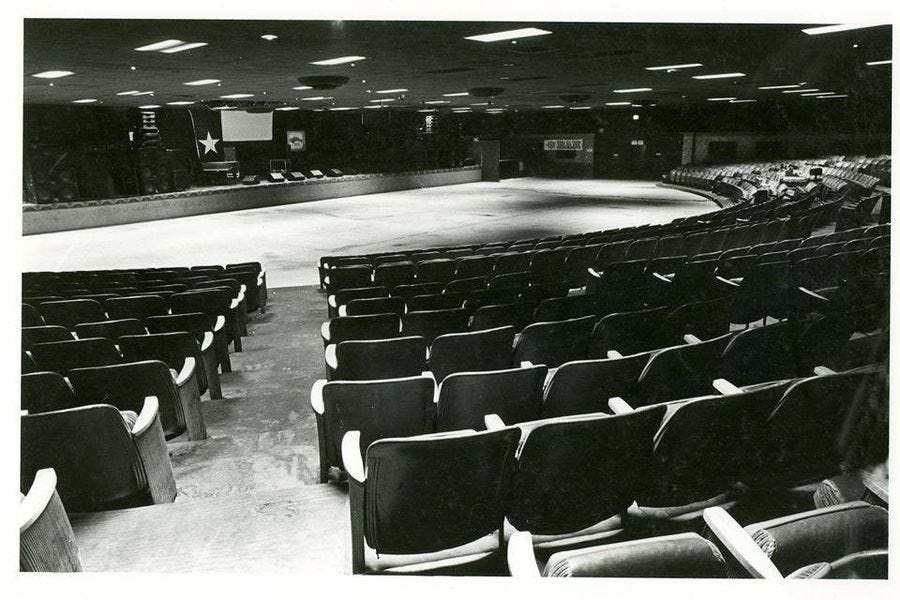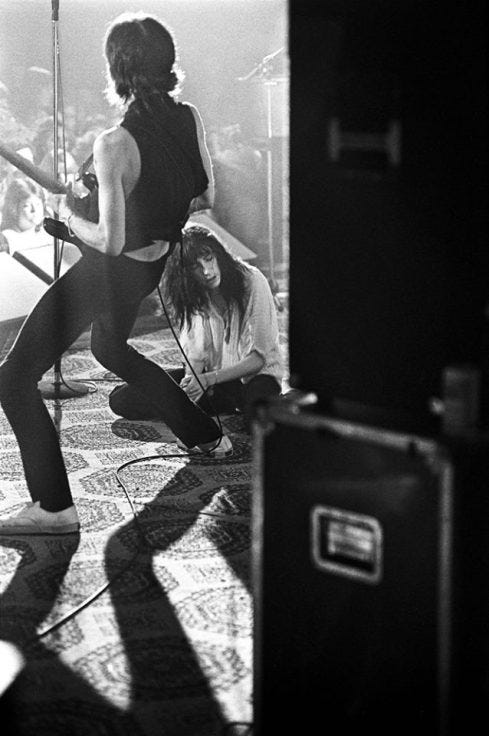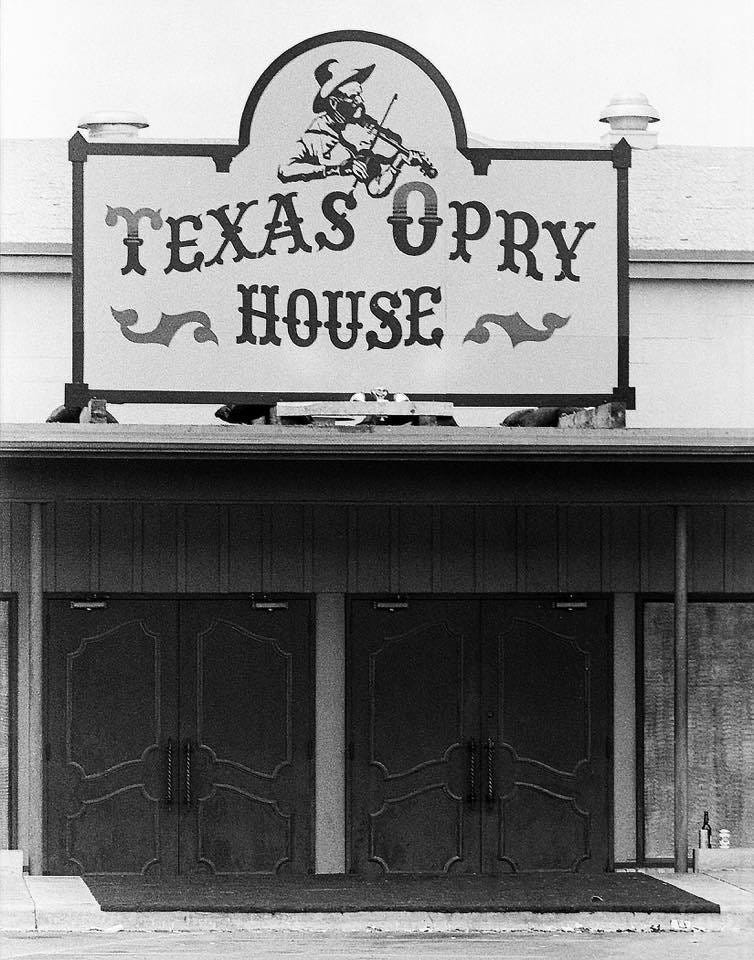Austin Opry/Opera House: The People's Temple of Willie
A cowboy hippie club with riser seating, AOH was the jewel of "the 14 Acres"

It’s always sad to lose a beloved music venue, even though another one usually takes its scorched place to reset the ecosystem. But has there been as good a place for a concert since the Austin Opera House closed in the early ‘90s? Maybe the Backyard, also run by Tim O’Connor, but the drive through Westlake and the rugged parking and the heat were negative factors that the 1,700-capacity room off South Congress didn’t have.
Liberty Lunch, the Continental Club and the Mohawk gave and give you raw, powerful, in-your-face experiences, but for pure music, wouldn’t you rather listen to Randy Newman, R.E.M., Tom Waits, Bonnie Raitt, Tina Turner, Dire Straits, Tom Petty, Lou Reed, Warren Zevon and even AC/DC and Iggy Pop in a venue where you could sit unobstructed, or stand in front of the stage if so moved?
The Armadillo had nachos, the Austin Opera House had popcorn- and fixed, tiered seating! That was the concept- a more comfortable auditorium for a slightly-aging fanbase.

Willie Nelson bought the entire Terrace Motor Hotel and Convention Center, with 300 rooms and two swimming pools, from developer L.L. McCandless in 1977 by assuming a million dollar note and handing over $5,000 in cash. This is the same “Music Lane” parcel that sold for $55 million not long ago. Ace Lumber owner McCandless built the Terrace in 1951 (and the Villa Capri in ‘57), then converted the convention center’s main ballroom into the private Terrace Club for jazz and big band dancing in 1965. But business hit hard times in the ‘70s. He rented the low-ceilinged Terrace Club space to the Texas Opry House in 1974, but after eight months of great shows, co-owner Bronson Evans bounced a $10,000 rent check in November and the venue didn’t make it to 1975.
There was a lot of new club activity in Austin in 1974, with a trio of Sixth Street district country bars- Alliance Wagon Yard (at the old 505 Neches location of Flight 505), River City Inn (304 E. Sixth), and the Cotton Exchange (formerly Toad Hall)- bonding to allow customers to barhop on only one cover charge. In October ‘74, Armadillo human mascot Jim Franklin and Bill Livingood reopened the Ritz movie theater (which had been showing porn) as a music venue. And the Dillo was on a roll as the favorite new venue for Bruce Springsteen, Bette Midler, Frank Zappa, Van Morrison and many more.
That the Texas Opry House got lost in the shuffle was bad news for Willie, who’d used the TOH as his homebase after a run-in with those peaceniks at the Armadillo, who asked that Willie take Smith and Wesson off the guest list. His crew was packin’ and that was fine with “Shotgun Willie”- he’d take his considerable draw elsewhere. Managed by Willie pal Wallace Selman from River City Inn, Texas Opry House was looking good in its quest to put the Armadillo out of business, opening with Doug Sahm, Augie Meyers and Freda and the Firedogs, then stealing the Eagles for it’s second concert in April ‘74. Waylon Jennings recorded his great Waylon Live album, with the Willie jab “Bob Wills Is Still the King,” there in Sept. ‘74.
Everybody loved the Opry House except its Fairview Park neighbors, whose streets became the venue’s parking lot, overrun by drunk concertgoers who couldn’t find their cars. One neighbor even had to turn the hose on fornicators in his front yard. The party started before the concerts and went on long after.
The TOH rent was $5,000 a month, plus 10% of the gross, but first the owners had to pay sales tax to get their liquor license restored. This was an ongoing problem. Outbidding the Armadillo for acts made for cash flow problems.
Though they were fierce competitors, the Armadillo and Texas Opry swapped acts once to better financially help the Opry and artistically boost the ‘Dillo. The Ray Charles for Michael Martin Murphey trade benefited both entities.
The venue was dormant from ‘75 to mid-’77, and the Terrace Motel was way behind on upkeep and intake. To make matters worse, “Dude” McCandless was rumored to have an unlucky run at the poker table. Willie, meanwhile was on a massive winning streak, with 1975’s Red Headed Stranger making him the national star he always knew he’d be. A deal was struck and Willie walked away with 14 acres at South Congress and Academy. He rehired his former business partner Tim O’Connor, who had to leave town for awhile after he accidentally shot someone at Alliance Wagon Yard in ‘75. This all happened very fast in May 1977.
Former clubowners Roger “One Knite” Collins and Tim “Castle Creek” O’Connor had been unemployed and doing the couch circuit together for about a month, when Tim woke up Roger that May morning and said “Get yer shit, we’re moving to the Terrace Motel.” They had their pick of rooms and Roger took a split-level suite near the pool. A big step up from Linda Schulmire’s sofa (or the floor, if O’Connor got there first). But Collins wouldn’t spend much time there, as Willie booked the grand opening concert, featuring him and Waylon Jennings, for exactly one month later! Thirty days to turn a carcass into a concert hall with a dancefloor.
“There was a lot of amphetamine,” says Collins, who was the venue manager. “We’d hand out those little white pills like candy.” The unemployment rate of hippie carpenters and stagehands was zero in Austin the month of June 1977. O’Connor brought in a field kitchen to keep the workers from going out to dinner and maybe not coming back to their low-paying jobs.
“We built the stage and risers, and Tim ordered 1800 seats,” recalls Collins. “When the truck came, we thought ‘there’s no way 1800 seats could fit in there,’ but the chairs were in three parts. Plus, there weren’t any nuts and bolts!” Assembling and installing the seats was a two-day, around the clock job, finished just a couple hours before the doors opened on June 28, 1977. “We were still painting when they let the audience in.”

The 200 Academy Drive complex included the ballroom, a banquet hall and other rooms- 42,000 square feet in all- so Willie and his nephew Freddy Fletcher also built a recording studio. Arlyn, where Stevie Ray Vaughan did much of his recording and Gary Clark Jr. still does, opened in 1984 and recorded parts of Vaughan’s Live Alive in ‘86. Because of its maze of hallways and back doors, the Austin Opry House was notoriously easy to sneak into. Every musician in town knew about the unguarded loading dock door. Or they waltzed right in through the Arlyn hallway to the best seats in the house- the infamous “cocaine catwalk.”
Remember the Texas Opry House that occupied 200 Academy Drive from 1974-1974? One of the three partners went to Houston and opened a new one, but soon left. The month after Willie and Tim opened their “Opry House,” the Houston Texas Opry House sued them for trademark infringement. At the trial, attorneys for Willie and O’Connor showed the jury a Bugs Bunny cartoon set at an “Opry House” to show the common usage. They seemed to be winning the case, when Nashville’s Grand Ol’ Opry also sent a cease and desist. Hands were thrown up and in September 1978, the name was officially changed to Austin Opera House, though ads still used the Opry House logo for another year or so. Everybody still called it “the Opry House.”
When I moved to Austin in ‘84, the Armadillo, Club Foot and Raul’s were closed, but I didn’t feel like I missed anything because there were great roadshows at the Austin Opera House, and serious punk rock action at a basement firetrap at 4th and Lavaca called Voltaire’s. I saw Elvis Costello and the Attractions at the Opera House soon after I got here- and they announced an impromptu second night, with opener Nick Lowe headlining and E.C. opening. I went to that show, too, and the Attractions played a country set after drinking all day at Lou Ann Barton’s and watching old country music TV shows. This sort of stuff didn’t happen in other cities I’d lived. Austin was off the cuff.

Even with everybody’s hero Willie involved, the neighborhood was not keen on the new concert hall, or all the hippies and druggies and roadies and musicians who had moved into the former Oak Terrace Apartments and bungalows that stretched across Academy, all the way to the back of the Continental Club. This was “Willie World,” a trailer park without wheels.
O’Connor wanted a place where the Opry crowd could drink until 2 a.m. after shows, so he had his crew convert the motel’s former front office at the corner of South Congress into the Backstage Bar, which later became the third and final location of Soap Creek. West Travis Heights had become Party Central against its will.
Nelson sold his majority share of the Opera House in 1988 to brothers Morris and Clark Lyda, who pulled out the seating and renamed it “The Terrace” like the old days. They put on some good shows, including the Pixies, Red Hot Chili Peppers, Neville Brothers and SXSW showcases with Little Village and Morphine, before concentrating on the banquet business because it was just as profitable, but with less wear and tear. They sold the building, which is still standing, to the YWCA in 1993. It’s been various offices, but not a music business, for the past 29 years.
The building is currently owned by Chris Wallin of Spearhead Properties, who are trying to remove a 1986 zoning overlay that prevents any new development of 200 Academy Drive. An investment group, including architect/musician Richard Weiss and Arlyn co-owners Freddy Fletcher and Will Bridges, have proposed a mixed-use development, that would include a buffer of residential housing between the concert hall and current neighbors. A compromise with the neighborhood is cutting capacity to around 1,000, which leaves room for an Austin Music Museum, no doubt filled with artifacts from the days when Willie ruled this roost.
The proposal goes before City Council on Jan. 27.








Great history Michael. I did the Wanted: The Outlaws tour in 1976 with Willie, Waylon, Jesi Colter and Tompall Glaser (I played with Tompall). We didn't play in Austin but later in 1977 we played the Opry House but I don't remember the date but I remember the venue. Lower ceiling as I recall and a lot of drunk people. Mel Brown on guitar and Ben Keith on steel (Mel moved to Austin and played organ in the Antone's house band later). But I was also doing dates with Sonny & Cher and still recording in Houston (Sugar Hill - Huey Meaux) and later that year joined Joan Armatrading and played the Paramount and the end of 1977 moved to LA. Lots of foggy memories but thanks for your history...
Saw Oingo Boingo there in 1986, epic show! Saw Echo and the Bunnymen there as well. Was a cool venue.